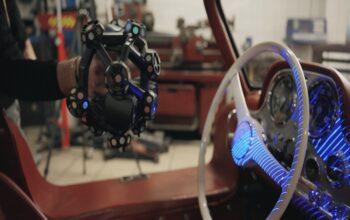Ford Motor Company is an American multi-national automaker that recently announced a plan to invest US$22 billion through 2025 in the electrification of their mobility products.
The Challenge
In electric vehicles (EVs), new processing methods for gears must convert the high-force torque from electric motors to the RPMs at the wheel. This much be achieved while also reaching the consumer’s intended distances efficiently and quietly.
To appeal to consumers, EVs need to have a comparable range to their internal combustion (IC) counterparts. This requires gears with reduced surface friction, increasing the vehicle’s overall range. In addition, the sound from IC engines tends to mask the noise from the drivetrain, such as gear noise; however, in EVs, these sounds are prominent unless there is a change to new gear manufacturing methods. This is where precision metrology plays a critical role in helping to establish a reliable monitor gear surface processing, enabling tighter specifications, and promoting meticulous quality control.
The Solution
Fabricating precise gear tooth form and flank texture can be a balancing act as meeting production demands reduces the time to inspect all parts. New gear grinding and polishing methods addressed this challenge for manufacturers. Today’s processing technology expedites the production of gears backed up by feedback from metrology to prevent manufacturing issues. For example, Ford Motor Company uses the ZYGO Nexview™ NX2™ for part inspection to verify their processes are both under control and producing consistent parts. ZYGO’s non-contact metrology solutions are preferred as they won’t mark the newly polished gear surfaces and capture larger areas quicker to ascertain if there is a process error.
In addition to its measurement precision, Ford selected the Nexview™ product for its EV gear line because ZYGO’s ‘home grown’ optical objectives meet stringent internal specifications required for precision measurements. Other considerations were the extreme stability of the measurement, ease of gaining access to the measurement area, as well as their demanding requirements for on-the-floor production metrology.
Another key tool built into ZYGO’s solutions is field stitching, which allows a matrix of overlapping measurements to be stitched together to form a larger measurement than a single objective can accomplish. This is advantageous in gear metrology: acquiring surface texture along a gear flank (from edge to edge) or stitching from the gear root to the tip, traversing over the involute shape. A hypoid gear can be re-measured with continuous high precision because of ZYGO proprietary stitching algorithms.
The Results
ZYGO’s 3D non-contact optical metrology solutions have proven critical to Ford’s ongoing manufacturing of high-precision automotive products.
By incorporating ZYGO metrology into their manufacturing processes, they have met stringent internal specifications required for precision measurements. Learn more about our ultra-precision metrology applications in the automotive industry.









